Exotic
Eupoecilia ambiguella (Hübner) (Tortricidae: Tortricinae: Cochylini)
Common names: European grape berry moth (preferred), European grape vine moth, grape berry moth
Synonyms: omphaciella (Tinea), roserana (Tortrix), turbinaris (Clysia)
FWL: 6.0-7.5 mm
The forewing is yellow or yellowish orange with a well-defined dark-brown to black median fasciafascia:
a dark transverse band on the forewing 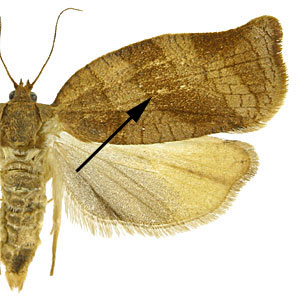 . Males and females exhibit no sexual dimorphism in wing pattern although females may be slightly larger than males. Males lack a forewing costal foldforewing costal fold:
. Males and females exhibit no sexual dimorphism in wing pattern although females may be slightly larger than males. Males lack a forewing costal foldforewing costal fold:
a flap or fold at the base of the forewing that contains specialized sex scales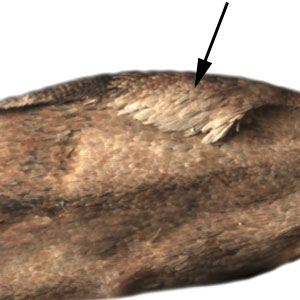 .
.
Male genitalia are characterized by a reduced uncusuncus:
a sclerotized process which is fused to the posterodorsal margin of tergum IX , short sociisocii:
, short sociisocii:
a pair of lightly sclerotized setose lobes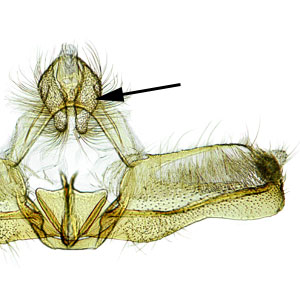 , prominent transtilla, distally triangular valvavalva:
, prominent transtilla, distally triangular valvavalva:
an appendage flanking the intromittent organ that is used to clasp the female during copulation 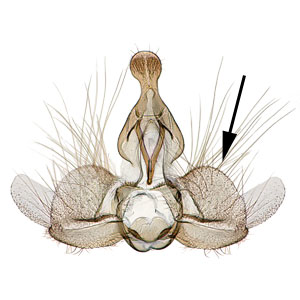 , and large phallusphallus:
, and large phallusphallus:
the male intromittent organ (penis); see "aedeagus" 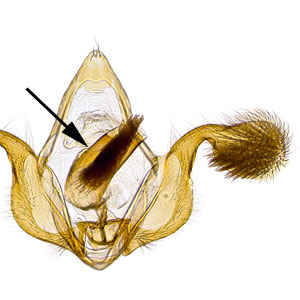 . Female genitalia are distinguished by a broad, short ductus bursaeductus bursae:
. Female genitalia are distinguished by a broad, short ductus bursaeductus bursae:
a membranous tube connecting the ostium bursae to the corpus bursae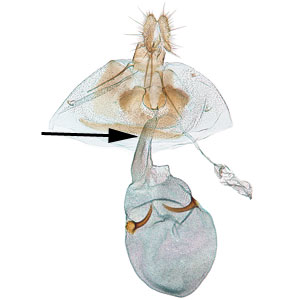 and a corpus bursaecorpus bursae:
and a corpus bursaecorpus bursae:
a dilated membranous sac at the anterior end of the bursa copulatrix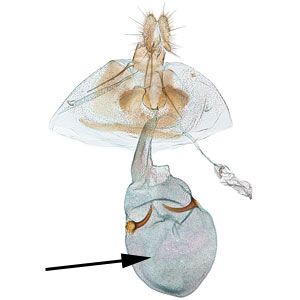 with numerous sclerotizations and spines.
with numerous sclerotizations and spines.
The following account is summarized from Gilligan & Epstein (2011).
Mature larvae approximately 10-12 mm in length. Head, prothoracic shieldprothoracic shield:
a sclerotized plate on the dorsal surface of the prothorax 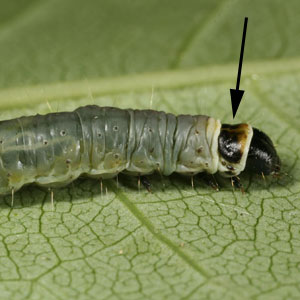 , legs dark brown to black; body color varies from brown to yellow and green; pinaculapinacula:
, legs dark brown to black; body color varies from brown to yellow and green; pinaculapinacula:
flattened sclerotized plates on a caterpillar that bear the setae large, conspicuous, brown; anal shieldanal shield:
large, conspicuous, brown; anal shieldanal shield:
a sclerotized plate on the dorsal surface of the last abdominal segment (in larvae) 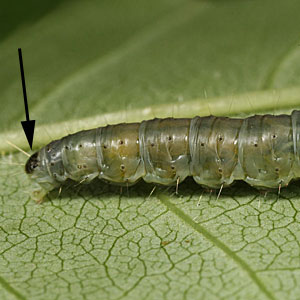 pale brown.
pale brown.
The following comments are summarized from Gilligan & Epstein (2011).
Adults may be confused with other species of Eupoecilia or Cochylini, although E. ambiguella is the only cochyline commonly associated with grape. A genitalic dissection can be used to confirm E. ambiguella identity.
Larvae cause damage similar to Lobesia botrana and the two species can be found sympatrically. Other tortricid grape pests include Argyrotaenia franciscana, Argyrotaenia ljungiana, Epiphyas postvittana, Paralobesia viteana, Platynota stultana, and Proeulia spp. Larvae of E. ambiguella can be separated from the larvae of other tortricid grape-feeding pests by the L-group pinaculum on T1, which extends horizontally beneath the spiracle in E. ambiguella.
The following account is summarized from Gilligan & Epstein (2011).
The biology of E. ambiguella is similar to that of Lobesia botrana, with the exception that there are two generations per year for E. ambiguella compared to three or more generations per year for L. botrana. Over most of its range, adults are present in May and June for the first generation and again in August and September for the second generation.
Females deposit eggs singly on buds, pedicels, and flowers during the first generation, and on grape berries during the second generation. Early instar larvae burrow into the buds or berries and feed internally; later instars web together buds or berries, and a single larva can feed on up to a dozen berries. Pupation occurs in leaves for the first generation and under bark for the second generation. Overwintering occurs as a second generation pupa. Development time is highly dependent on temperature and humidity. The optimum relative humidity level for development is 70% or higher; eggs will fail to hatch at low relative humidity levels.
Economic losses on grape are caused by direct feeding damage and secondary infections. Larvae of the first generation cause minor damage by feeding on flower buds, while those of the second generation cause the most damage by feeding on grape berries. The most significant losses are due to secondary infection of feeding sites on berries and clusters by Botrytis cinerea fungus. Economic thresholds vary with the type of grape and cultivar.
Although grape (Vitis vinifera) is the most economically important host, E. ambiguella has been recorded from many different plants in several families.
| Host plant | Host plant family | Reference(s) |
| Acer campestre | Aceraceae | Razowski 1970Razowski 1970: Razowski, J. 1970. Cochylidae. In : Amsel, H. G., F. Gregor amp; H. Reiser (eds.), Microlepidoptera Palaearctica, vol 3. Verlag G. Fromme amp; Co., Wien. 528 pp. |
| Eleutherococcus sp. | Araliaceae | Kuznetzov 1978Kuznetzov 1978: Kuznetzov, V. I. 1978. Family Tortricidae (Olethreutidae, Cochylidae), pp. 193-680. In : Medvedev, G. S. (ed.), Keys to the insects of the European part of the USSR 4(1). Opred. Faune SSSR (117): 193-686 [In Russian; English version published for the National Science Foundation (Washington, DC) by Amerind Publishing Co.]. |
| Hedera helix | Araliaceae | Razowski 1970Razowski 1970: Razowski, J. 1970. Cochylidae. In : Amsel, H. G., F. Gregor amp; H. Reiser (eds.), Microlepidoptera Palaearctica, vol 3. Verlag G. Fromme amp; Co., Wien. 528 pp. |
| Hedera sp. | Araliaceae | Kawabe 1982Kawabe 1982: Kawabe, A. 1982. Tortricidae and Cochylidae, pp. 62-151. In : Inoue, H., Sugi, S., Kuroko, H., Moriuti, S., Kawabe, A. (eds.), The Moths of Japan, Part 1: 62-258, Part 2: 158-183. |
| Lonicera periclymenum | Caprifoliaceae | Bradley et al. 1973Bradley et al. 1973: Bradley, J. D., Tremewan, W. G., Smith, A. 1973. British Tortricoid Moths, Cochylidae and Tortricidae: Tortricinae. The Ray Society, London. 251 pp. |
| Lonicera ramosissima | Caprifoliaceae | Razowski 1970Razowski 1970: Razowski, J. 1970. Cochylidae. In : Amsel, H. G., F. Gregor amp; H. Reiser (eds.), Microlepidoptera Palaearctica, vol 3. Verlag G. Fromme amp; Co., Wien. 528 pp. |
| Lonicera sp. | Caprifoliaceae | Kawabe 1982Kawabe 1982: Kawabe, A. 1982. Tortricidae and Cochylidae, pp. 62-151. In : Inoue, H., Sugi, S., Kuroko, H., Moriuti, S., Kawabe, A. (eds.), The Moths of Japan, Part 1: 62-258, Part 2: 158-183. |
| Symphoricarpos sp. | Caprifoliaceae | Kuznetzov 1978Kuznetzov 1978: Kuznetzov, V. I. 1978. Family Tortricidae (Olethreutidae, Cochylidae), pp. 193-680. In : Medvedev, G. S. (ed.), Keys to the insects of the European part of the USSR 4(1). Opred. Faune SSSR (117): 193-686 [In Russian; English version published for the National Science Foundation (Washington, DC) by Amerind Publishing Co.]. |
| Viburnum sp. | Caprifoliaceae | Razowski 1970Razowski 1970: Razowski, J. 1970. Cochylidae. In : Amsel, H. G., F. Gregor amp; H. Reiser (eds.), Microlepidoptera Palaearctica, vol 3. Verlag G. Fromme amp; Co., Wien. 528 pp. |
| Cornus mas | Cornaceae | Razowski 1970Razowski 1970: Razowski, J. 1970. Cochylidae. In : Amsel, H. G., F. Gregor amp; H. Reiser (eds.), Microlepidoptera Palaearctica, vol 3. Verlag G. Fromme amp; Co., Wien. 528 pp. |
| Cuscuta reflexa | Cuscutaceae | USNM Collection |
| Cuscuta sp. | Cuscutaceae | Ashton & Santana 1976 |
| Ribes sp. | Grossulariaceae | Bradley et al. 1973Bradley et al. 1973: Bradley, J. D., Tremewan, W. G., Smith, A. 1973. British Tortricoid Moths, Cochylidae and Tortricidae: Tortricinae. The Ray Society, London. 251 pp.; Kawabe 1982Kawabe 1982: Kawabe, A. 1982. Tortricidae and Cochylidae, pp. 62-151. In : Inoue, H., Sugi, S., Kuroko, H., Moriuti, S., Kawabe, A. (eds.), The Moths of Japan, Part 1: 62-258, Part 2: 158-183. |
| Ligustrum sp. | Oleaceae | Razowski 1970Razowski 1970: Razowski, J. 1970. Cochylidae. In : Amsel, H. G., F. Gregor amp; H. Reiser (eds.), Microlepidoptera Palaearctica, vol 3. Verlag G. Fromme amp; Co., Wien. 528 pp. |
| Syringa x persica | Oleaceae | Bradley et al. 1973Bradley et al. 1973: Bradley, J. D., Tremewan, W. G., Smith, A. 1973. British Tortricoid Moths, Cochylidae and Tortricidae: Tortricinae. The Ray Society, London. 251 pp. |
| Frangula alnus Mill. | Rhamnaceae | Bradley et al. 1973Bradley et al. 1973: Bradley, J. D., Tremewan, W. G., Smith, A. 1973. British Tortricoid Moths, Cochylidae and Tortricidae: Tortricinae. The Ray Society, London. 251 pp.; Jaros & Spitzer 2002 |
| Rhamnus sp. | Rhamnaceae | Bradley et al. 1973Bradley et al. 1973: Bradley, J. D., Tremewan, W. G., Smith, A. 1973. British Tortricoid Moths, Cochylidae and Tortricidae: Tortricinae. The Ray Society, London. 251 pp.; Kawabe 1982Kawabe 1982: Kawabe, A. 1982. Tortricidae and Cochylidae, pp. 62-151. In : Inoue, H., Sugi, S., Kuroko, H., Moriuti, S., Kawabe, A. (eds.), The Moths of Japan, Part 1: 62-258, Part 2: 158-183. |
| Prunus sp. | Rosaceae | Bradley et al. 1973Bradley et al. 1973: Bradley, J. D., Tremewan, W. G., Smith, A. 1973. British Tortricoid Moths, Cochylidae and Tortricidae: Tortricinae. The Ray Society, London. 251 pp.; Kawabe 1982Kawabe 1982: Kawabe, A. 1982. Tortricidae and Cochylidae, pp. 62-151. In : Inoue, H., Sugi, S., Kuroko, H., Moriuti, S., Kawabe, A. (eds.), The Moths of Japan, Part 1: 62-258, Part 2: 158-183. |
| Parthenocissus quinquefolia | Vitaceae | Disque 1908Disque 1908: Disque, H. 1908. Versuch einer microlepidopterologischen Botanik. Deutsch Entomologische Zeitschrift Iris. 21: 34-147. |
| Vitis vinifera | Vitaceae | Razowski 1970Razowski 1970: Razowski, J. 1970. Cochylidae. In : Amsel, H. G., F. Gregor amp; H. Reiser (eds.), Microlepidoptera Palaearctica, vol 3. Verlag G. Fromme amp; Co., Wien. 528 pp.; Bradley et al. 1973Bradley et al. 1973: Bradley, J. D., Tremewan, W. G., Smith, A. 1973. British Tortricoid Moths, Cochylidae and Tortricidae: Tortricinae. The Ray Society, London. 251 pp.; Vrabl et al. 1983Vrabl et al. 1983: Vrabl, S., Matis, G., Berber, K. 1983. The results of research on the spread of grape moths ( Lobesia botrana Den. et Schiff. and Eupoecilia ambiguella Hb.) by means of pheromones in Slovenia. Zastita Bilja. 34: 457-464 [In Serbo-Croatian]. |
View full screen host table here
Eupoecilia ambiguella is widely distributed across the Palearctic, where it is more common in cooler and humid climates. It has been reported from Brazil (EPPO 2007), but this record could not be verified. It is not considered established outside of Europe and Asia.